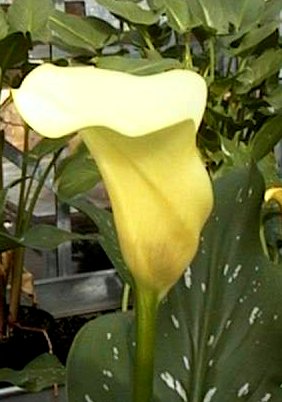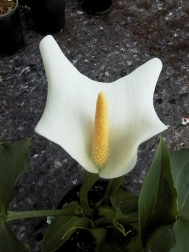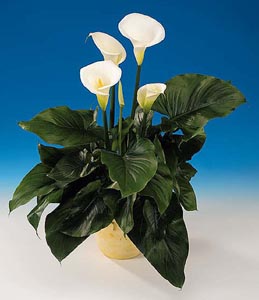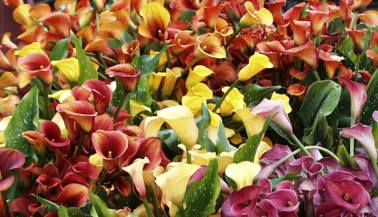





Zantedeschia, also calla lily orarum lily, is a growing crop in the Netherlands. Total cut flowersales at the Dutch auction were increased in 1999 for 29% to almost �16 million (ca. US$ 15 million). For ensuring growth of Zantedeschia as a crop, it is essential to tackle the biggest problem in culture:the occurrence of soft rot caused by Erwinia carotovora subsp. carotovora. Therefore, incooperation with six Zantedeschia-related companies, PlantResearch International is doing resistance breeding research in Zantedeschia against Erwinia soft rot. In this program,resistance of Zantedeschia to Erwinia will be increased.
7.Erwinia carotovora subsp. carotovora
![]() Createsoft rot resistant varieties with coloured blooms
Createsoft rot resistant varieties with coloured blooms
The occurrence of soft rot caused byErwinia carotovora subsp. carotovora isthe biggest problem in growing Zantedeschia in the Netherlands .This is a bacterial disease that can destroy harvests in just a fewdays. All existing hybrids are considered susceptible to a certaindegree, resistant varieties with coloured are not known.
![]() Overcome intersectional breeding barriers
Overcome intersectional breeding barriers
In order to transfer resistance from Z. aethiopica to coloured Aestivae varieties, huge breeding barriers have to be overcome.
Because of fore-mentioned breedingbarriers between Z. aethiopica and Aestivae-types, we have tolook for alternative sources of resistance. After testing, thereappears to be (partial) resistance to Erwinia soft rot in theAestivae-group. We are now researching the genetics behind thisresistance.
![]() Introgress resistance of
Z. aethiopica into the Aestivae assortment see further
overcomingbreeding barriers
Introgress resistance of
Z. aethiopica into the Aestivae assortment see further
overcomingbreeding barriers
![]() Exploit variation in resistance already present in the coloured
Aestivae assortment
Exploit variation in resistance already present in the coloured
Aestivae assortment
![]() Develop resistance test for measuring resistance levels of individualplants
and of clones
Develop resistance test for measuring resistance levels of individualplants
and of clones
![]() Screen the total Aestivae assortment for resistance to
erwiniasoft rot
Screen the total Aestivae assortment for resistance to
erwiniasoft rot
![]() Use Z. odorata as bridge species, or crossing of Z.aethiopica
and Z. odorataor Aestivae
with Z. odorata. However, understandingincompatibilities between the
species' genomes and plastomes isessential.
Use Z. odorata as bridge species, or crossing of Z.aethiopica
and Z. odorataor Aestivae
with Z. odorata. However, understandingincompatibilities between the
species' genomes and plastomes isessential.
For more online information on breedingbarriers in Zantedeschia, see:
http://www.hortnet.co.nz/news/note/calscent.htm
For moreinformation on plastome-genome incompatibilities in Zantedeschia,see:
Yao,J.-L., D. Cohen and R.E. Rowland. 1994. Plastid inheritance andplastome-genome incompatibility in interspecific hybrids ofZantedeschia (Araceae). Theoretical and AppliedGenetics 88:255-260.
Yao,J.-L., D. Cohen and R.E. Rowland. 1995. Interspecific albino andvariegated hybrids in the genus Zantedeschia. Plant Science109: 199-206.
Yao,Y.-L. and D. Cohen. 2000. Multiple gene control of plastome-genomeincompatibility and plastid DNA inheritance in interspecific hybridsof Zantedeschia. Theoretical and Applied Genetics. 101:400-406.
![]() A disease test for determining Erwinia resistance has beendeveloped
A disease test for determining Erwinia resistance has beendeveloped
![]() Z. aethiopica is not fully resistant
Z. aethiopica is not fully resistant
![]() Aestivae types vary in their level of susceptibility:
Aestivae types vary in their level of susceptibility:

Figure. Share of infected tuber tissueafter artificial infection with Erwinia carotovora subsp.carotovora of various Aestivae cultivars (99011-99017)
![]() Low susceptible Aestivae-types have been hybridised
Low susceptible Aestivae-types have been hybridised
 Z. aethiopica
Z. aethiopicaAlso known as:
(Dutch): Aronskelk,calla
(Afrikaans): Aronskelk, maartblom, hottentotsblare,hottentotsbrood, varkblom,
varkoor, varklelie, varkwortel,ystervarkwortel
(English): White Arum, arum lily, calla lily,Jack-in-the-pulpit, lily of
the Nile, pig lily
(Zulu):iNtebe
Characteristics:
![]() Erwinia resistant
Erwinia resistant
![]() Vigorous growth
Vigorous growth
![]() White blooms
White blooms
For more online information on culture Z. aethiopica see also:
For more online information on Araceae-species:

Also known as:
(Dutch):zantedeschia, kleurcalla
(English): calla lily, Group1-calla's
Aestivae is the scientific name for the botanicalsection of species where
Aestivae types are derived from. Aestivaespecies include:
![]() Z. albomaculata
Z. albomaculata
![]() Z. elliotiana
Z. elliotiana
![]() Z. jucunda
Z. jucunda
![]() Z. pentlandii
Z. pentlandii
![]() Z. rehmannii
Z. rehmannii
Characteristics:
![]() Erwinia susceptible
Erwinia susceptible
![]() Coloured blooms
Coloured blooms
For more information on Aestivae group:
Singh,Y., A.E. van Wyk and H. Baijnath. 1996. Taxonomic notes on the genus Zantedeschia Spreng. (Araceae) in southern Africa. SouthAfrica Journal of Botany 62 (6): 321-324.
For more online information on Aestivae type Zantedeschia, see also
http://www.hortnet.co.nz/news/note/flower_mrkt.htm
Soft rot in Zantedeschia ispredominantly caused by Erwinia carotovora subsp. carotovora.This is a gram negative bacterium that can destroy plants and in factwhole crops within days. There is no agrochemical known that cansuppress it. Cultural measures have to be taken to minimise losses.Because of the mechanisms that the bacterium uses enter the plant,namely brute force, probably resistance inherits polygenically.
For more online information on Erwinia ,see also
http://www.waite.adelaide.edu.au/Teaching/Diagnosis/softrot.htm
For more online information oncontrolling Erwinia, see also
http://www.crop.cri.nz/psp/articles/docs/callarot.htm